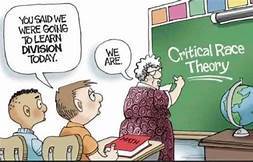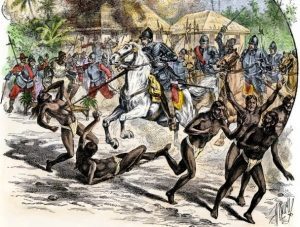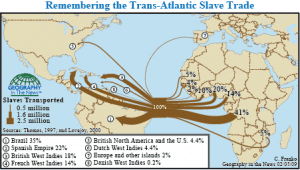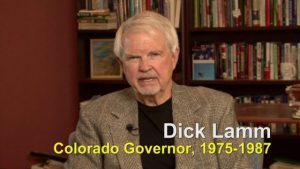Ronald E. Yates's Blog, page 41
February 28, 2022
A remarkable must-read story and highly recommended by Artisan Book Reviews. 5 Big Stars!
February 23, 2022
The Sad State of American Journalism
February 22, 2022
The Roots of Our Political Divide
February 20, 2022
O Canada, What Have You Done?
February 17, 2022
Big Improvements to ForeignCorrespondent: It’s Now Easier to Comment
February 16, 2022
Major Improvements to ForeignCorrespondent: It’s Now Easier to Comment
February 15, 2022
The True Story of 1619 and America’s Origins
Most Americans have heard of something called the “1619 Project.” If you are one of those who haven’t, here is what the spurious 3-year-old notion posits in a nutshell:
America wasn’t founded in 1776 with the Declaration of Independence. It was actually founded in 1619 when the first 20 slaves from Africa were brought to the British colony of Point Comfort, Virginia.
Thus, everything that America would become originated with slavery, not with a courageous declaration that sought freedom from the British crown 157 years later.
Sadly, this pseudo-historical gibberish has been embraced by some American school districts and is already poisoning the malleable minds of children as young as five and six years of age. I have often railed against the 1619 Project along with its equally idiotic twin called Critical Race Theory–a malicious, racist, and duplicitous theory that teaches children that all white people on the planet are oppressors and all black, brown, yellow, and red people are victims of white oppression.
This is racist ersatz history taught by socialist K-12 teachers and left-wing professors in colleges and universities. It is designed to divide us further than we already are by pitting children against one another based on race, religion, and ethnicity.
It is disgusting, destructive, and dangerous.
Recently, I read an excellent analysis of the 1619 Project in the Epoch Times. I am reposting that article here. I hope you find it useful in understanding this fallacious claptrap and twaddle that masquerades as an accurate history of America.
The True Story of 1619 and America’s Origins
by
In fall 2019, The New York Times released a special edition of its magazine, highlighting what it claimed was the 400th anniversary of the first African slaves arriving in the territory that would later become the United States of America.
The NY Times sought to completely alter the story of America’s past, and it has largely enjoyed stunning success. Despite the fact that this “project” is now 3 years old, it still carries substantial weight and was even released in book form in late 2021. Millions of dollars from backers have ensured that the 1619 Project has managed to slip into virtually every classroom in the United States. This Black History Month, with so many people still believing the 1619 Project’s premises, it’s worthwhile to review the many, many ways in which they are little more than bankrupt propaganda.
The opening page of the 1619 Project asks, “What if we were to tell you that this fact, which is taught in our schools and unanimously celebrated every Fourth of July, is wrong, and that the country’s true birth date, the moment that its defining contradictions first came into the world, was in late August of 1619?”
The alleged importance of the year 1619, it explains, is that the year “was when a ship arrived at Point Comfort in the British colony of Virginia, bearing a cargo of 20 to 30 enslaved Africans.”
“Their arrival inaugurated a barbaric system of chattel slavery that would last for the next 250 years. This is sometimes referred to as the country’s original sin, but it is more than that: it is the country’s very origin,” the introduction reads.
This introduction of black slaves into Virginia, only a short distance from the Jamestown colony, is the premise upon which the rest of the 1619 Project flows. The introduction proceeds to claim that “out of slavery … grew nearly everything that has truly made America exceptional: its economic might, its industrial power, its electoral system,” among a litany of other things. Slavery, they claim, is the defining part of America’s past and the interpretive framework through which everything ought to be viewed.
However, the biggest problem with this is that it’s 100 percent historically wrong—1619 wasn’t the nation’s “true birth date.” Nor was it the beginning of chattel slavery. Nor was it even the first time African slaves were brought to continental America.
To start with, slavery existed in the Americas long before any European so much as even dreamed of crossing the vast expanse of the Atlantic Ocean. When Columbus and subsequent Spanish explorers landed in the New World, they discovered that slavery was already deeply entrenched in the indigenous societies there. Indeed, slavery was ubiquitous in pre-Columbian America. The native slave trade was so prolific that “wherever European conquistadors set foot in American tropics, they found evidence of indigenous warfare, war captives, and captive slaves,” as Fernando Santos-Granero wrote in his book “Vital Enemies.” Modern estimates suggest that 20 percent to 40 percent of the native American cultures were enslaved—putting them on par with the slave empires of the ancient Greeks, imperial Romans, and even the Confederate South.
African slaves were introduced to what would later become the continental United States by the Spanish in as early as 1526, when they attempted to plant a colony along the Carolina coast with “seven vessels, 600 men and women, among whom were several slaves, and 83 horses,” as the Georgia Historical Society recounted in 1923. In 1528, another Spanish expedition set out to explore the continental mainland of America. It was led by Pánfilo de Narváez, who brought with him nearly 400 men, both black and white, among whom was the famed African slave from Morocco named Estevanico. Even if we were to dismiss these two events as outliers and failed ventures, the Spanish still brought nearly 500 African slaves when they successfully founded the permanent colony of St. Augustine in 1565.
Lastly, the evidence suggests that the Africans brought to Jamestown in 1619 were incorporated into the colony not as slaves, but rather as indentured servants. The year prior to their arrival, the Jamestown colony began a system where “an enterprising captain or ship owner would himself enlist recruits at London,” and “on arrival at Jamestown, the recruits would be auctioned off to the highest bidder for a specified term,” as William J. Wood wrote in an article for the American Bar Association Journal. These white English servants would be “sold” on an auction block to owners, whom they would serve without pay for whatever was the term of their indenture. This quickly became the standard for Jamestown immigration.
Therefore, in 1619, when a privateer brought a captured ship to Jamestown with about 20 African slaves on board, the slaves weren’t technically sold into slavery, but rather were indentured. At the end of their indenture term, the African servants would be freed just like the white indentured servants from England. Afterward, many were given land to farm and became members of society. One of the original 1619 Africans, Anthony Johnson, actually became a substantial landowner and “found the environment of seventeenth-century Virginia conducive to the amassing of property in land or chattel,” as James H. Brewer wrote for The William and Mary Quarterly.
So then, what may be actually said about the year 1619? It wasn’t when slavery was introduced to America—slavery was a widespread practice among the native Americans. It wasn’t the first time African slaves were introduced to America—that was in 1526. It wasn’t the first time African slaves were introduced to a permanent settlement in the land that would eventually become the United States—that was in 1565. It wasn’t even the first time life-long black slaves were bought and sold in an English colony in America—the evidence suggests that they were instead introduced as indentured servants under similar terms as white colonists.
Ultimately, the only thing we can historically say about the year 1619 is that it represented the first time Africans were introduced as indentured servants into an English-speaking permanent colony in the area that would become the United States of America more than 150 years later—an extremely qualified statement and substantially different from what the 1619 Project falsely claims. During Black History Month 2022, let’s learn the truth about our nation’s past.
Timothy Barton is the president of WallBuilders, a national organization dedicated to highlighting the true facts about the founding of America, our Constitution, and our rich history.
February 11, 2022
Playing ‘Privilege Bingo’ in Fairfax Co. Virginia
Now, THIS is disgusting. A high school English class in a Fairfax, Virginia school recently instructed students to play “privilege bingo,” in which students were told to check boxes that showed how privileged they were.
For example, there were boxes for being white, Christian, male, and able-bodied to identify whether the student was considered privileged. There was also a box for being the child of a military family.
Say what?
You are a “privileged” child if one or both of your parents are members of America’s armed forces?
I would never have thought a child is considered privileged when one of his/her parents was posted overseas possibly engaged in combat.
I’m not sure how risking one’s life in the military makes a child “privileged.” Or, for that matter, I can’t see how being white, or employed, or “cisgender,” or mentally healthy, or Christian, makes you a privileged oppressor.
But that is the essence of Critical Race Theory that posits that if you are not a minority you are “privileged” and by extension, an “oppressor.” Given that many in the military are minorities and only about 2-4 percent of the U.S. population are active members of the military, I wonder how that makes them “privileged?”
Assistant Superintendent Douglas A. Tyson of Fairfax County Public Schools told concerned parents that the screenshot in question originated from “an approved English Curriculum lesson that is centered around students selecting a ‘choice’ test and examining in detail the author’s perspective on a wide-range [sic] of issues.”
The exercise, Tyson continued, was designed for students to determine whether authors have “privilege that may or may not be present in the work” and then reflect on their own biases based on their race as well as economic and educational status.
Parents and students in Virginia who have fought critical race theory and other radical ideologies in their schools over the last two years, however, aren’t pleased.
“This is yet another district in America that is teaching children to identify themselves and treat others by characteristics that, in this case for the military thing, is absolutely meaningless,” Nicole Neily, President of Parents Defending Education, said.
Neily noted that parents are growing increasingly frustrated with the district’s handling of COVID-era schooling and the divisive curriculum that puts students in boxes.
“These are students who, at the end of the day, want to get a good grade, are picking up on these cues from their teachers, right? And so they regurgitate these talking points and things like this. And I think it’s very difficult for students to say what they need to say to get a good grade while maintaining kind of their own perspective on issues. This feels very coercive, quite honestly,” Neily said. “…Fairfax parents, obviously, have been extremely outspoken about their unhappiness with a number of elements of the school system.”
On his first day in office, Gov. Glen Youngkin announced a series of executive orders designed to curb the radicalization of the state’s public school system. One of his orders banned curriculum that claims “some students are consciously or unconsciously racist, sexist, or oppressive, and that other students are victims.”
The actions include an executive order ending the use of inherently divisive concepts – including Critical Race Theory – in public education, and an executive order affirming the rights of parents to make decisions on masks in schools.
“Teaching Critical Race Theory denies our students the opportunity to gain important facts, core knowledge, formulate their own opinions, and to think for themselves. Our children deserve far better from their education than to be told what to think,” Youngkin explained.
Despite these orders, some Northern Virginia school districts are refusing to comply. Fairfax County Public Schools announced this week that it will continue “universal mask-wearing” in its schools.
I wonder how I survived school and actually received a good education when Critical Race Theory was not part of the curriculum when I was in school back in the Pleistocene era.
Of course that curricular oversight allowed me to live my life not as an oppressor, but as a simple, loyal, and proud American–something that appears in today’s divided and perverse America to be no longer possible.
February 10, 2022
How to Destroy America: A Plan from a Liberal Democrat
As I have witnessed the violence, hatred, looting, and destruction taking place in the United States at the hands of anarchists, ANTIFA goons, and Black Lives Matter rioters I thought back to a five-minute speech I once heard by former liberal Democrat Colorado Governor Richard D. Lamm. I didn’t hear it personally; I heard it as a recording.
The speech was entitled: “I have a plan to destroy America.” It was delivered on Oct. 3, 2005. Various iterations of it have been around for a while, including revisions. Today, I am sharing the text of the speech below. I believe it was one Lamm made later, because it has been expanded a bit.
However, I have attached a link to the original speech at the end of this post for your listening pleasure and, I hope, edification.
I have a plan to destroy America
by Richard D. Lamm
I have a secret plan to destroy America. If you believe, as many do, that America is too smug, too white bread, too self-satisfied, too rich, let’s destroy America. It is not that hard to do. History shows that nations are more fragile than their citizens think. No nation in history has survived the ravages of time. Arnold Toynbee observed that all great civilizations rise and they all fall, and that “an autopsy of history would show that all great nations commit suicide.” Here is my plan:
We must first make America a bilingual-bicultural country. History shows, in my opinion, that no nation can survive the tension, conflict, and antagonism of two competing languages and cultures. It is a blessing for an individual to be bilingual; it is a curse for a society to be bilingual. One scholar, Seymour Martin Lipset, put it this way: “The histories of bilingual and bicultural societies that do not assimilate are histories of turmoil, tension, and tragedy. Canada, Belgium, Malaysia, Lebanon all face crises of national existence in which minorities press for autonomy, if not independence. Pakistan and Cyprus have divided. Nigeria suppressed an ethnic rebellion. France faces difficulties with its Basques, Bretons, and Corsicans.”
I would then invent “multiculturalism” and encourage immigrants to maintain their own culture. I would make it an article of belief that all cultures are equal: that there are no cultural differences that are important. I would declare it an article of faith that the black and Hispanic dropout rate is only due to prejudice and discrimination by the majority. Every other explanation is out-of-bounds.
We can make the United States a “Hispanic Quebec” without much effort. The key is to celebrate diversity rather than unity. As Benjamin Schwarz said in the Atlantic Monthly recently, “The apparent success of our own multiethnic and multicultural experiment might have been achieved, not by tolerance, but by hegemony. Without the dominance that once dictated ethnocentrically, and what it meant to be an American, we are left with only tolerance and pluralism to hold us together.”
I would encourage all immigrants to keep their own language and culture. I would replace the melting pot metaphor with a salad bowl metaphor. It is important to ensure that we have various cultural sub-groups living in America reinforcing their differences, rather than Americans emphasizing their similarities.
Having done all this, I would make our fastest-growing demographic group the least educated. I would add a second underclass, unassimilated, undereducated, and antagonistic to our population. I would have this second underclass have a 50 percent dropout rate from school.
I would then get the big foundations and big business to give these efforts lots of money. I would invest in ethnic identity, and I would establish the cult of victimology. I would get all minorities to think their lack of success was all the fault of the majority. I would start a grievance industry blaming all minority failure on the majority population.
I would establish dual citizenship and promote divided loyalties. I would “celebrate diversity.” “Diversity” is a wonderfully seductive word. It stresses differences rather than commonalities. Diverse people worldwide are mostly engaged in hating each other–that is when they are not killing each other. A “diverse,” peaceful, or stable society is against most historical precedents. People undervalue the unity it takes to keep a nation together, and we can take advantage of this myopia.
Look at the ancient Greeks. Dorf’s “World History,” tells us: “The Greeks believed that they belonged to the same race; they possessed a common language and literature, and they worshiped the same gods. All Greece took part in the Olympic Games in honor of Zeus, and all Greeks venerated the shrine of Apollo at Delphi. A common enemy, Persia, threatened their liberty. Yet, all of these bonds together were not strong enough to overcome two factors … (local patriotism and geographical conditions that nurtured political divisions …)”
If we can put the emphasis on the “Pluribus,” instead of the “Unum,” we can balkanize America as surely as Kosovo.
Then I would place all these subjects off-limits–make it taboo to talk about. I would find a word similar to “heretic” in the 16th century that stopped discussion and paralyzed thinking. Words like “racist”, “xenophobe” halt argument and conversation. Having made America a bilingual-bicultural country, having established multiculturalism, having the large foundations fund the doctrine of “victimology,” I would next make it impossible to enforce our immigration laws. I would develop a mantra –” because immigration has been good for America, it must always be good.” I would make every individual immigrant sympatric and ignore the cumulative impact.
Lastly, I would censor Victor Davis Hanson’s book “Mexifornia” –this book is dangerous; it exposes my plan to destroy America. So please, please–if you feel that America deserves to be destroyed–please, please–don’t buy this book! This guy is on to my plan.
“The smart way to keep people passive and obedient is to strictly limit the spectrum of acceptable opinion, but allow very lively debate within that spectrum.” –Noam Chomsky, American linguist, and U.S. media and foreign policy critic.
Richard D. Lamm was a liberal Democrat who served as governor of Colorado for twelve years from 1975 to 1987. In 2005, a speech attributed to him, on the perils of multiculturalism, became a viral item online:
February 9, 2022
Proud to be an American
I don’t know Hal Morris. Never met him. I received his commentary from a friend and it resonated with me because of its honesty and the author’s palpable love of our country. I hope you will find it as poignant and authentic as I did.
PROUD TO BE AN AMERICAN
by Hal Morris
I was born in the Bronx, New York, in 1935, but grew up in a small rural hamlet called Oak Ridge in the Catskills near Ellenville. We moved there in 1942, the dark days of WWII, and were the first Jewish family in the area. I grew up attending a one-room school, grades 1-8 from, 1943 to 1949.
It was rural America at its finest hour. Each morning in school, we recited the Lord’s Prayer, sang the National Anthem, recited the Pledge of Allegiance, and saluted the Flag. We all respected and felt proud if chosen to hold the Flag during the morning ceremonies.
It is interesting to note there were only 25 students in our school, 15 White and 10 black. Because we were such a small student body, everybody had to participate in games. We played, fought, and grew to like or dislike because of actions against each other, not because of our race or economic levels.
We were proud to be Americans and especially proud of our neighbors who had gone off to War. As children, versed in the War’s progress, we followed the battle lines on an old Mercator map hung by the blackboard.
When we had free time, we biked and visited each other’s homes. It was as if we were one. None of my friends went away to camp during the summer. The shortage of men caused many of the women and children to do farm work. I went to work with my older classmates picking bush beans during the summer. It was hot, dusty, and difficult to fill up bushels of beans and carry them to the truck for 25 cents a bushel. If we worked hard, we could earn as much as $1.50 a day and $7.50 for the week. I learned responsibility, getting up a 5 AM, riding a workers truck to the fields. Coming home at 4 PM, we helped with feeding chickens, mowing hay, and cleaning barns. When I was ten, I learned to drive a small Chevy dump truck and a Ford tractor. I remember being so proud of the responsibility. People depended upon children, and we delivered.
In June of 1944, we learned the two neighborhood Sheely boys had died landing at Normandy. The family lived down the road. We also heard that same month that Louis Rabin, the brother of one of our students, had been shot down over France and taken Prisoner. The War was coming right home to us and fast. Funny, that right after that news, we stopped playing war games.
What made it very real to me was when our neighbors across the road, the Carsons, heard their son Harry, who they thought was missing in action, was captured in the Philippines. Harry was a star athlete and baseball player signed by the New York Giants in 1940. He enlisted in the Army and was stationed on Corregidor in the Philippines. They had given me his bat and glove to use. I was nine years old and so proud of Harry and cried when I found out. Happily, Harry survived Japanese confinement, and, when he returned in November of 1945, he weighed less than one hundred pounds and suffered from TB.
Those early years, growing up without material things, in a rural setting, going to a one-room integrated school, understanding how hard it is to be a migrant worker, how difficult it is to be a farmer, literally shaped by life today. I learned to respect hard work and the people who worked what some consider menial jobs. Eighty-five years later, I know my roots, and I appreciate those who work and use their hands in manufacturing and jobs we consider menial. I am proud and thankful to be born an American Citizen.
I worked my way through high school and college. Had a successful career in private industry, and retired after over thirty years as a school superintendent. I earned two Master’s degrees and a Doctorate from Columbia University. I realized success and disappointment but was always thankful that I lived in this country that enabled a poor boy to have an opportunity to succeed.
It pains me to see our democracy and free enterprise economy threatened. It pains me to see the complacency spreading among our young. It disgusts me to see both black and white as well as other minorities hoodwinked for false political purposes. I’ve worked in countries practicing communism. I’ve traveled throughout Europe and Asia and met and spoken with individuals who lived and worked under socialism. I’ve seen and looked into their eyes and seen the hope that someday they to could come and live in America. I pity the young, entitled, rich who have their lives on a silver platter but don’t understand what freedom and equality mean.
I learned the truth is what matters. Looting, violence, and hatred can only divide and not win. The phrase attributed to the ancient Greek storyteller Aesop, ” United we stand, divided we fall was historically paraphrased by Patrick Henry,” Let us not split into factions which must destroy that union upon which our existence hangs.” It’s easy to forget the struggles of parents who sacrificed so that the young have it better than they did growing up. So they protest, riot, and destroy to make things better. How ironic.
The politics of today will have a profound effect on the lives of so many to come. Will they have opportunities to become self-sustained individuals and families? Will our grandchildren live in a country that values free enterprise, lives within its means, and provides shelter to those in need?
The use of racial injustices to divide is deplorable. Recent polls indicate that many Americans view society as racist. Racism, antisemitism, discrimination against Hispanics, and Asians happen. Historically all ages and races have practiced individual racism and antisemitism all over the world. Because a black person calls a Jew a “Kike” doesn’t mean all blacks are antisemitic. It means that person is ignorant and prejudiced against Jews. It doesn’t mean all blacks are believers in systemic antisemitism.
So let’s stand up to the polls and refute the myth of systemic racism. It doesn’t exist today. That it did during the Democratic/Socialist Party support of Jim Crow Laws, doesn’t make it so today. Systemic racism will exist, so long as individuals believe that problems are brought about by others.
Unfortunately, the solutions for most of the problems of poor urban black individuals and families exist within the black American population. The BLM movement’s recent statements have negated the importance of stability in family structure stability reinforced by sociological studies and the Moynihan report in 1965. This denial of family stability reinforces the belief that others cause their situation.
Politicians, trying to overcome defeat, regain strength and power need division, and cause problems to gain votes. By ignoring the reality of family structure, they prolong the solution to the problem.
Some say we are now at a crossroads. As Woody Allen so aptly stated in his speech to graduates, ” One road faces death and destruction while at the same time the other faces total annihilation. Let us hope we have the wisdom to choose wisely.” The humor of Allen illustrates the doom and gloom of the advocates of systemic racism. We don’t have to make such a choice. Ours is relatively simple. Do we love and respect our country as it stands? Can we within our system continue our fight for greater equality? We don’t need to wander around to fix a problem that doesn’t exist. We need to concentrate on building what is right.
Yes! I say we can and will! Let us not throw away all that is good. Look at the continued growth of the black and Hispanic middle classes. Look and develop increased job opportunities that can be available for weak urban areas. Despite Democratic/Socialists’ efforts to subvert such valuable opportunities, Republican efforts to create opportunity zones need to increase.
It made no sense to elect a Democratic/Socialist Party candidate for president. Biden’s platform stressed giveaways, free health care for all, free tuition, and relief from student debt. These are all unrealistic proposals without sustainable means of payment.
If legislation is adopted to support such recommendations, personal, small business and corporate tax brackets will soar. Even with that, there wouldn’t be enough revenue to pay for all the proposals. To make up the difference, the Democrats would cut defense spending, infrastructure plans, and border security budgets.
The Utopian ideas sound appealing but are not at all realistic.
We face neither death nor destruction. We don’t face annihilation.
What we face is a revolution trying to overthrow our economy and our form of government. We face a choice between free enterprise progress to new heights or a hard move towards socialism.
I pick free enterprise heights and the Rule of Law.












